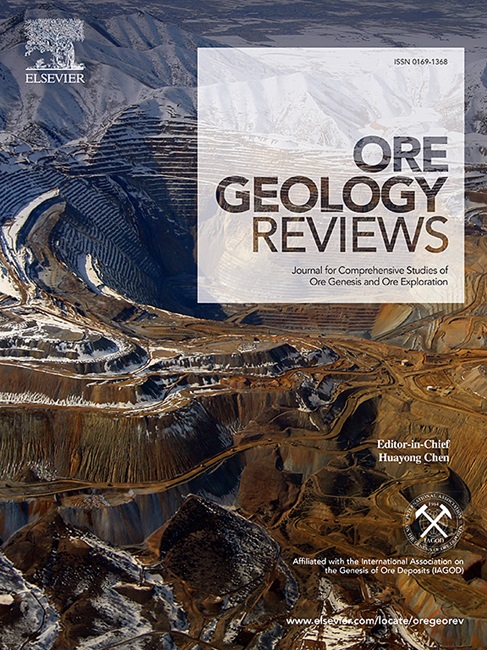贵州省东部(中国西南部)变质基底新化铅锌铜脉型矿床的硫化物痕量元素富集
IF 3.2
2区 地球科学
Q1 GEOLOGY
引用次数: 0
摘要
寒武纪碳酸盐岩层广泛分布于湖南西部-贵州东部地区(中国西南部),该地区拥有许多密西西比河谷型(MVT)铅锌(Pb-Zn)矿床。区域性铅锌矿化在基底新生代板溪组的低品位变质岩中发育良好。矿化与石英脉有关,一般沿东北走向的断层带分布。此外,这些矿床分布广、品位高,并伴有铜-银赋存。然而,对这些铅锌矿脉型矿床的地质和地球化学研究相对有限,它们与区域 MVT 矿化的关系仍不明确。我们选择了丹寨地区具有代表性的新华矿床作为研究对象。我们对各成矿期的闪锌矿和黄铜矿进行了原位微量元素分析,并与已发表的湘西-黔东成矿带 MVT 铅锌矿床的闪锌矿微量元素数据进行了对比。迄今为止,新化铅锌矿已发现七个矿体,锌+铅金属资源量超过 12 万吨。野外地质学和显微岩石学揭示了两个成矿阶段:LA-ICPMS 数据表明,新华闪锌矿的微量元素组成与该地区 MVT 铅锌矿床的微量元素组成相似。它们相对富含镓、镉和锗,而缺乏铁、钴和锰。临界金属 Ge 和 Ga 在闪锌矿中特别富集,尤其是在 Sp-I 中(Ge 最大含量为 937 ppm,Ga 最大含量为 824 ppm)。闪锌矿中 Ge 和 Ga 的置换机制可能是 2Cu+ + Ge4+ ↔ 3Zn2+ 和 Cu+ + Ga3+ ↔ 2Zn2+。铟和锡主要存在于 Sp-I 和 Sp-III。黄铜矿中的锌和锡含量都超过了 100 ppm。黄铜矿中的硒、银、铟和锡含量明显高于闪锌矿。闪锌矿微量元素地温计(GGIMFis)的计算表明,闪锌矿成矿的平均温度分别为164 °C(Sp-I)、156 °C(Sp-II)和205 °C(Sp-III),这意味着中低温成矿。总之,断层控制的脉型铅锌矿床(如新华矿床)可能与其他地层结合的MVT矿床一样,是同一广安造山运动的产物,新华矿床具有两个成矿阶段和多种矿石金属源。在成矿流体上升过程中,一些成矿物质可能沉淀在流体通道中。并在较浅的层状矿体和地层被侵蚀后暴露出来。因此,新化铅锌矿床代表了(基底地层中的)MVT成矿作用中保存下来的成矿流体导管阶段。本文章由计算机程序翻译,如有差异,请以英文原文为准。

Sulfide trace element enrichments in the metamorphic basement-hosted Xinhua Pb-Zn-Cu vein-type deposit, eastern Guizhou province (SW China)
Cambrian carbonate formations are widespread in the western Hunan-eastern Guizhou region (southwestern China), which hosts many Mississippi Valley-Type (MVT) lead–zinc (Pb-Zn) deposits. Regional Pb-Zn mineralization is well developed in the low-grade metamorphic rocks of the basal Proterozoic Banxi Group. The mineralization is associated with quartz veins and generally distributed along NE-trending fault zones. Moreover, these deposits have an extensive distribution and high grade, and are associated with Cu-Ag endowment. However, geological and geochemical research on these Pb-Zn vein-type deposits is relatively limited, and their relationship with the regional MVT mineralization remains unclear. The representative Xinhua deposit in Danzhai district is selected as the study subject. We conducted in situ trace element analyses on the sphalerite and chalcopyrite from the various metallogenic stages, and compared them with published sphalerite trace element data from the MVT Pb-Zn deposits in the western Hunan-eastern Guizhou metallogenic belt. Seven orebodies in Xinhua Pb-Zn deposit have been discovered so far, with a metal resource of over 120,000 metric tonnes of Zn + Pb. Field geology and microscopic petrography have revealed two mineralization stages: An early-stage black sphalerite (Sp-I) followed by reddish-brown sphalerite (Sp-II) mineralization, which corresponds to the main chalcopyrite mineralization stage, and a later-stage light-yellow sphalerite (Sp-III), Cu ore-barren mineralization.
LA-ICPMS data indicate that the sphalerite from Xinhua has similar trace element compositions to those from the MVT Pb-Zn deposits in the region. They are relatively enriched in Ga, Cd, and Ge, while depleted in Fe, Co, and Mn. Critical metal Ge and Ga are particularly enriched in sphalerite, especially in Sp-I (Ge max 937 ppm, Ga max 824 ppm). The substitution mechanism of Ge and Ga in sphalerite are likely 2Cu+ + Ge4+ ↔ 3Zn2+ and Cu+ + Ga3+ ↔ 2Zn2+. Indium and Sn are mainly present in Sp-I and Sp-III. Chalcopyrite contains Zn and Sn both exceeding 100 ppm. Contents of Se, Ag, In, and Sn in chalcopyrite are significantly higher than those in sphalerite. Calculation of the sphalerite trace element geothermometer (GGIMFis) suggests that the average sphalerite ore-forming temperatures are 164 °C (Sp-I), 156 °C (Sp-II), and 205 °C (Sp-III), implying medium- to low-temperature mineralization. This indicates a possible influx of high-temperature, in-bearing fluid during the late-stage mineralization.
In summary, the faults-controlled vein-type Pb-Zn deposits (e.g., Xinhua) may have been products of the same Kwangsian orogeny as other strata bound MVT deposits, and the Xinhua deposit features two mineralization stages with multiple ore metal sources. During the ore-forming fluid ascent, some ore-forming materials may have precipitated in the fluid conduits. And exposed after the erosion of the shallower stratiform orebodies and strata. Consequently, the Xinhua Pb-Zn deposit represents the preserved ore-fluid conduit phase (in the basement strata) of the MVT mineralization.
求助全文
通过发布文献求助,成功后即可免费获取论文全文。
去求助
来源期刊

Ore Geology Reviews
地学-地质学
CiteScore
6.50
自引率
27.30%
发文量
546
审稿时长
22.9 weeks
期刊介绍:
Ore Geology Reviews aims to familiarize all earth scientists with recent advances in a number of interconnected disciplines related to the study of, and search for, ore deposits. The reviews range from brief to longer contributions, but the journal preferentially publishes manuscripts that fill the niche between the commonly shorter journal articles and the comprehensive book coverages, and thus has a special appeal to many authors and readers.
 求助内容:
求助内容: 应助结果提醒方式:
应助结果提醒方式:


